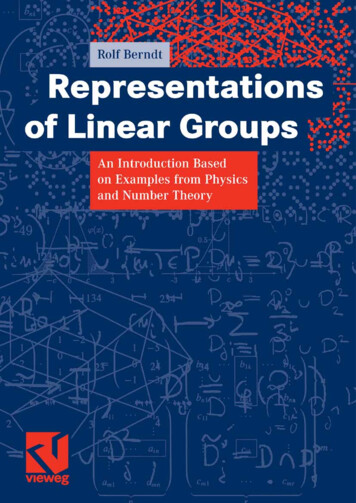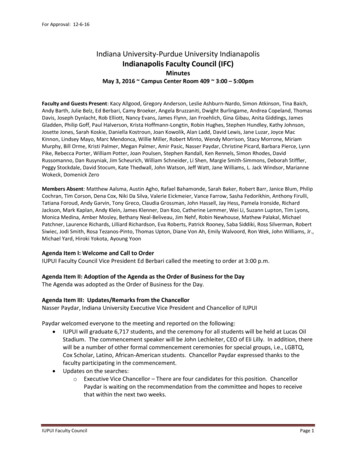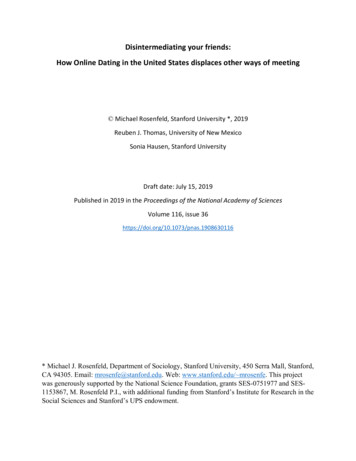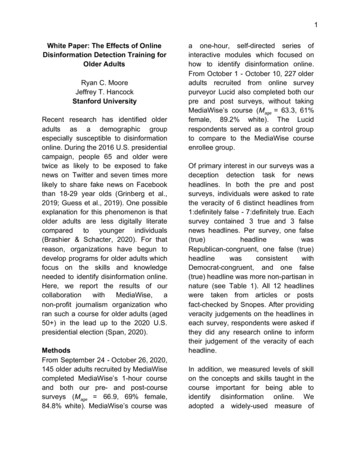
Transcription
Rolf BerndtRepresentationsof Linear Groups
Rolf BerndtRepresentationsof Linear GroupsAn Introduction Basedon Examples from Physicsand Number Theory
Bibliografische information published by Die Deutsche NationalbibliothekDie Deutsche Nationalbibliothek lists this publication in the Deutschen Nationalbibliografie;detailed bibliographic data is available in the Internet at http://dnb.d-nb.de .Prof. Dr. Rolf BerndtDepartment of MathematicsUniversity of HamburgBundesstraße 55D-20146 s Subject Classification20G05, 22E45, 20C25, 20C35, 11F70First edition, July 2007All rights reserved Friedr. Vieweg & Sohn Verlag GWV Fachverlage GmbH, Wiesbaden 2007Editorial Office: Ulrike Schmickler-Hirzebruch Susanne JahnelVieweg is a company in the specialist publishing group Springer Science Business Media.www.vieweg.deNo part of this publication may be reproduced, stored in a retrieval systemor transmitted, mechanical, photocopying or otherwise without priorpermission of the copyright holder.Cover design: Ulrike Weigel, www.CorporateDesignGroup.dePrinting and binding: MercedesDruck, BerlinPrinted on acid-free paperPrinted in GermanyISBN 978-3-8348-0319-1
PrefaceThere are already many good books on representation theory for all kinds of groups.Two of the best (in this author’s opinion) are the one by A.W. Knapp: “RepresentationTheory for Semisimple Groups. An Overview based on Examples” [Kn1] and by G.W.Mackey: “Induced Representations in Physics, Probability and Number Theory” [Ma1].The title of this text is a mixture of both these titles, and our text is meant as a veryelementary introduction to these and, moreover, to the whole topic of group representations, even infinite-dimensional ones. As is evident from the work of Bargmann [Ba],Weyl [Wey] and Wigner [Wi], group representations are fundamental for the theory ofatomic spectra and elementary physics. But representation theory has proven to be aninavoidable ingredient in other fields as well, particularly in number theory, as in thetheory of theta functions, automorphic forms, Galois representations and, finally, theLanglands program. Hence, we present an approach as elementary as possible, having inparticular these applications in mind.This book is written as a summary of several courses given in Hamburg for students ofMathematics and Physics from the fifth semester on. Thus, some knowledge of linearand multilinear algebra, calculus and analysis in several variables is taken for granted.Assuming these prerequisites, several groups of particular interest for the applications inphysics and number theory are presented and discussed, including the symmetric groupSn as the leading example for a finite group, the groups SO(2), SO(3), SU(2), and SU(3)as examples of compact groups, the Heisenberg groups and SL(2, R), SL(2, C), resp. theLorentz group SO(3, 1) as examples for noncompact groups, and the Euclidean groupsE(n) SO(n) Rn and the Poincaré group P SO(3, 1) R4 as examples for semidirect products.This text would not have been possible without the assistance of my students and colleagues; itis a pleasure for me to thank them all. In particular, D. Bahns, S. Böcherer, O. v. Grudzinski,M. Hohmann, H. Knorr, J. Michaliček, H. Müller, B. Richter, R. Schmidt, and Chr. Schweigerthelped in many ways, from giving valuable hints to indicating several mistakes. Part of thematerial was treated in a joint seminar with Peter Slodowy. I hope that a little bit of his wayof thinking is still felt in this text and that it is apt to participate in keeping alive his memory.Finally, I am grateful to U. Schmickler-Hirzebruch and S. Jahnel from the Vieweg Verlag forencouragement and good advice.
ContentsIntroductionix0 Prologue: Some Groups and their0.1 Several Matrix Groups . . . . . .0.2 Group Actions . . . . . . . . . .0.3 The Symmetric Group . . . . . .Actions. . . . . . . . . . . . . . . . . . . . . . . . . . . . . . . . . . . . . . . . . . . . . . . . . . . . . . . . . . . . . . . . . . .1 Basic Algebraic Concepts1.1 Linear Representations . . . . . . . . . . .1.2 Equivalent Representations . . . . . . . .1.3 First Examples . . . . . . . . . . . . . . .1.4 Basic Construction Principles . . . . . . .1.4.1 Sum of Representations . . . . . .1.4.2 Tensor Product of Representations1.4.3 The Contragredient Representation1.4.4 The Factor Representation . . . .1.5 Decompositions . . . . . . . . . . . . . . .1.6 Characters . . . . . . . . . . . . . . . . . .113577910141414151616212 Representations of Finite Groups232.1 Characters as Orthonormal Systems . . . . . . . . . . . . . . . . . . . . . 232.2 The Regular Representation . . . . . . . . . . . . . . . . . . . . . . . . . . 272.3 Characters as Orthonormal Bases . . . . . . . . . . . . . . . . . . . . . . 283 Continuous Representations3.1 Topological and Linear Groups3.2 The Continuity Condition . . .3.3 Invariant Measures . . . . . . .3.4 Examples . . . . . . . . . . . .31313338404 Representations of Compact Groups434.1 Basic Facts . . . . . . . . . . . . . . . . . . . . . . . . . . . . . . . . . . . 434.2 The Example G SU(2) . . . . . . . . . . . . . . . . . . . . . . . . . . . . 484.3 The Example G SO(3) . . . . . . . . . . . . . . . . . . . . . . . . . . . 525 Representations of Abelian Groups595.1 Characters and the Pontrjagin Dual . . . . . . . . . . . . . . . . . . . . . 595.2 Continuous Decompositions . . . . . . . . . . . . . . . . . . . . . . . . . . 60
viiiCONTENTS6 The6.16.26.36.46.56.6Infinitesimal MethodLie Algebras and their Representations . . . . . . . . . . . . . .The Lie Algebra of a Linear Group . . . . . . . . . . . . . . . .Derived Representations . . . . . . . . . . . . . . . . . . . . . .Unitarily Integrable Representations of sl(2, R) . . . . . . . . .The Examples su(2) and heis(R) . . . . . . . . . . . . . . . . .Some Structure Theory . . . . . . . . . . . . . . . . . . . . . .6.6.1 Specifications of Groups and Lie Algebras . . . . . . . .6.6.2 Structure Theory for Complex Semisimple Lie Algebras6.6.3 Structure Theory for Compact Real Lie Algebras . . . .6.6.4 Structure Theory for Noncompact Real Lie Algebras . .6.6.5 Representations of Highest Weight . . . . . . . . . . . .The Example su(3) . . . . . . . . . . . . . . . . . . . . . . . . .63. 63. 67. 70. 73. 82. 84. 85. 89. 93. 95. 97. 1047 Induced Representations7.1 The Principle of Induction . . . . . . . . . . . . . . . . . . . . .7.1.1 Preliminary Approach . . . . . . . . . . . . . . . . . . .7.1.2 Mackey’s Approach . . . . . . . . . . . . . . . . . . . . .7.1.3 Final Approach . . . . . . . . . . . . . . . . . . . . . . .7.1.4 Some Questions and two Easy Examples . . . . . . . . .7.2 Unitary Representations of SL(2, R) . . . . . . . . . . . . . . .7.3 Unitary Representations of SL(2,C) and of the Lorentz Group .7.4 Unitary Representations of Semidirect Products . . . . . . . . .7.5 Unitary Representations of the Poincaré Group . . . . . . . . .7.6 Induced Representations and Vector Bundles . . . . . . . . . .1171171181201251261301431471541618 Geometric Quantization and the Orbit Method8.1 The Hamiltonian Formalism and its Quantization . . . . . . . . . . . . . .8.2 Coadjoint Orbits and Representations . . . . . . . . . . . . . . . . . . . .8.2.1 Prequantization . . . . . . . . . . . . . . . . . . . . . . . . . . . . .8.2.2 Example: Construction of Line Bundles over M P1 (C) . . . . .8.2.3 Quantization . . . . . . . . . . . . . . . . . . . . . . . . . . . . . .8.2.4 Coadjoint Orbits and Hamiltonian G-spaces . . . . . . . . . . . . .8.2.5 Construction of an Irreducible Unitary Representation by an Orbit8.3 The Examples SU(2) and SL(2, R) . . . . . . . . . . . . . . . . . . . . . .8.4 The Example Heis(R) . . . . . . . . . . . . . . . . . . . . . . . . . . . . .8.5 Some Hints Concerning the Jacobi Group . . . . . . . . . . . . . . . . . .1731731781781811841861961972022099 Epilogue: Outlook to Number Theory9.1 Theta Functions and the Heisenberg Group . . . . . . . . . . .9.2 Modular Forms and SL(2,R) . . . . . . . . . . . . . . . . . . .9.3 Theta Functions and the Jacobi Group . . . . . . . . . . . . . .9.4 Hecke’s Theory of L Functions Associated to Modular Forms .9.5 Elements of Algebraic Number Theory and Hecke L-Functions9.6 Arithmetic L-Functions . . . . . . . . . . . . . . . . . . . . . .9.7 Summary and Final Reflections . . . . . . . . . . . . . . . . . 66
IntroductionIn this book, the groups enumerated in the Preface are introduced and treated as matrixgroups to avoid as much as possible the machinery of manifolds, Lie groups and bundles(though some of it soon creeps in through the backdoor as the theory is further developed). Parallel to information about the structure of our groups we shall introduce anddevelop elements of the representation theory necessary to classify the unitary representations and to construct concrete models for these representations. As the main toolfor the classification we use the infinitesimal method linearizing the representations of agroup by studying those of the Lie algebra of the group. And as the main tools for theconstruction of models for the representations we use– tensor products of the natural representation,– representations given by smooth functions (in particular polynomials) living on aspace provided with an action of the group,and– the machinery of induced representations.Moreover, because of the growing importance in physics and the success in derivingbranching relations, the procedure of geometric quantization and the orbit method, developed and propagated by Kirillov, Kostant, Duflo and many others shall be explainedvia its application to some of the examples above.Besides the sources already mentioned, the author was largely influenced by the nowclassical book of Kirillov: “Elements of the Theory of Representations” [Ki] and themore recent “Introduction to the Orbit Method” [Ki1]. Other sources were the booksby Barut and Raczka: “Theory of Group Representations and Applications” [BR], S.Lang: “SL(2, R)” [La], and, certainly, Serre: “Linear Representations of Finite Groups”[Se]. There is also the book by Hein: “Einführung in die Struktur- und Darstellungstheorie der klassischen Gruppen” [Hei], which follows the same principle as our text,namely to do as much as possible for matrix groups, but does not go into the infinitedimensional representations necessary for important applications. Whoever is furtherinterested in the history of the introduction of representation theory into the theory ofautomorphic forms and its development is referred to the classical book by Gelfand, Graevand Pyatetskii-Shapiro: “Representation Theory and Automorphic Forms” [GGP], Gelbart’s: “Automorphic Forms on Adèle Groups” [Ge], and Bump’s: “Automorphic Formsand Representations” [Bu]. More references will be given at the appropriate places in ourtext; as already said, we shall start using material only from linear algebra and analysis.But as we proceed more and more elements from topology, functional analysis, complexfunction theory, differential and symplectic geometry will be needed. We will try to introduce these as gently as possible but often will have to be very rudimentary and willhave to cite the hard facts without the proofs, which the reader can find in the morerefined sources.
To sum up, this text is prima facie about real and complex matrices and the nice andsometimes advanced things one can do with them by elementary means starting froma certain point of view: Representation theory associates to each matrix from a givengroup G another matrix or, in the infinite-dimensional case, an operator acting on aHilbert space. One may want to ask, why study these representations by generally morecomplicated matrices or operators if the group is already given by possibly rather simplematrices? An answer to this question is a bit like the one for the pudding: the proofis in the eating. And we hope our text will give an answer. To the more impatientreader who wants an answer right away in order to decide whether to read on or not, weoffer the following rough explanation. Certain groups G appear in nature as symmetrygroups leaving invariant a physical or dynamical system. For example, the orthogonalgroup O(3) is the symmetry group for the description of the motion of a particle in acentral symmetric force field, and the Poincaré group P is the symmetry group for themotion of a free particle in Minkowski space. Then the irreducible unitary representations of G classify indivisible intrinsic descriptions of the system and, boldly spoken, canbe viewed as “elementary particles” for the given situation. Following Wigner and hiscontemporaries, the parameters classifying the representations are interpreted as quantum numbers of these elementary particles. . .The importance of representations for number theory is even more difficult to put into anutshell. In the Galois theory of algebraic number fields (of finite degree) Galois groupsappear as symmetry groups G. Important invariants of the fields are introduced via certain zeta- or L-functions, which are constructed using finite-dimensional representationsof these Galois groups. Another aspect comes from considering smooth (holomorphicresp. meromorphic) functions in several variables which are periodic or have a more general covariant transformation property under the action of a given discrete subgroup ofa continuous group G, like for instance G SL(2, R) or G a Heisenberg or a symplecticgroup. Then these functions with preassigned types, e.g., theta functions or modularforms, generate representation spaces for (infinite-dimensional) representations of the respective group G.Finally, we will give an overview over the contents of our text: In a prologue we will fixsome notation concerning the groups and their actions that we later use as our first examples, namely, the general and special linear groups over the real and complex numbersand the orthogonal and unitary groups. Moreover, we present the symmetric group Snof permutations of n elements and some facts about its structure. We stay on the level ofvery elementary algebra and stick to the principle to introduce more general notions anddetails from group theory only when needed in our development of the representationtheory. We follow this principle in the first chapter where we introduce the concept oflinear representations using only tools from linear algebra. We define and discuss thefundamental notions of equivalence, irreducibility, unitarity, direct sums, tensor product,characters, and give some first examples.The theory developed thus far is applied in the second chapter to the representations offinite groups, closely following Serre’s exposition [Se]. We find out that all irreduciblerepresentations may be unitarized and are contained in the regular representation.
In the next step we move on to compact groups. To do this we have to leave the purelyalgebraic ground and take in topological considerations. Hence, in the third chapter, wedefine the notion of a topological and of a (real or complex) linear group, the centralnotion for our text. Following this, we refine the definition of a group representation byadding the usual continuity condition. Then we adequately modify the general conceptsof the first chapter. We try to take over as much as possible from finite to compactgroups. This requires the introduction of invariant measures on spaces with a (from nowon) continuous group action, and a concept of integration with respect to these measures.In the forth chapter we concentrate on compact groups and prove that the irreduciblerepresentations are again unitarizable, finite-dimensional, fixed by their characters andcontained in the regular representation. But their number is in general not finite, incontrast to the situation for finite groups. We state, but do not prove, the Peter-WeylTheorem. But to get a (we hope) convincing picture, we illustrate it by reproducingWigner’s discussion of the representaions of SU(2) and SO(3). We use and prove thatSU(2) is a double cover of SO(3). Angular momentum, magnetic and spin quantumnumbers make an appearance, but for further application to the theory of atomic spectrawe refer to [Wi] and the physics literature.In a very short fifth chapter, we assemble some material about the representations oflocally compact abelian groups. We easily get the result that every unitary irreduciblerepresentation is one-dimensional. But as can be seen from the example G R, theirnumber need not be denumerable. More functional analysis than we can offer at thisstage is needed to decompose a given reducible representation into a direct integral ofirreducibles, a notion we not consider here.Before starting the discussion of representations of other noncompact groups, we presentin chapter 6 an important tool for the classification of representations, the infinitesimalmethod. Here, at first, we have to explain what a Lie algebra is and how to associateone to a given linear group. Our main ingredient is the matrix exponential function andits properties. We also reflect briefly on the notion of representations of Lie algebras.Here again we are on purely algebraic, at least in examples, easily accessible ground.We start giving examples by defining the derived representation dπ of a given grouprepresentation π. We do this for the Schrödinger representation of the Heisenberg groupand the standard representation π1 of SU(2). Then we concentrate on the classificationof all unitary irreducible representations of SL(2, R) via a description of all (integrable)representations of its Lie algebra. Having done this, we consider again the examples su(2)and heis(R) (relating them to the theory of the harmonic oscillator) and give some hintsconcerning the general structure theory of semisimple Lie algebras. The way a generalclassification theory works is explained to some extent by considering Lie SU(3); we willsee how quarks show up.Chapters 7 and 8 are the core of our book. In the seventh chapter we introduce theconcept of induced representations, which allows for the construction of (sometimesinfinite-dimensional) representations of a given group G starting from a (possibly onedimensional) representation of a subgroup H of G. To make this work we need again abit more Hilbert space theory and have to introduce quasi-invariant measures on spaceswith group action. We illustrate this by considering the examples of the Heisenberggroup and G SU(2), where we rediscover the representations which we already know.Then we use the induction process to construct models for the unitary representations of
SL(2, R) and SL(2, C). In particular, we show how holomorphic induction arises in thediscussion of the discrete series of SL(2, R) (here we touch complex function theory). Weinsert a brief discussion of the Lorentz group GL SO(3, 1)0 and prove that SL(2, C)is a double cover of GL . To get a framework for the discussion of the representations ofthe Poincaré group GP , which is a semidirect product of the Lorentz group with R4 , wedefine semidirect products and treat Mackey’s theory in a rudimentary form. We outlinea recipe to classify and construct irreducible representations of semidirect products ifone factor is abelian. We do not prove the general validity of this procedure as Mackey’sImprimitivity Theorem is beyond the scope of our book, but we apply it to determinethe unitary irreducible rep
Prof. Dr. Rolf Berndt Department of Mathematics University of Hamburg Bundesstraße 55 D-20146 Hamburg Germany berndt@math.uni-hamburg.de Mathematics Subject Classification 20G05, 22E45, 20C25, 20C35, 11F70File Size: 2MB











